本文目录
英语中数字的读法规则百度文库PPT
英语中数字的读法规则如下:
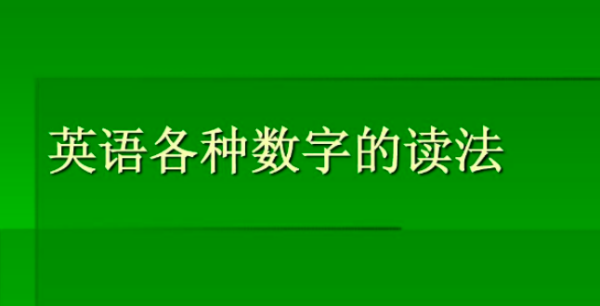
1到20之间,直接读单个的数字;读大于20的数字,先读十位数再读个位数:7-seven,32-thirty-two,89-eighty-nine;当表达大于100的数字时,以“百”为单位来读,顺序为十亿、百万、千、百。
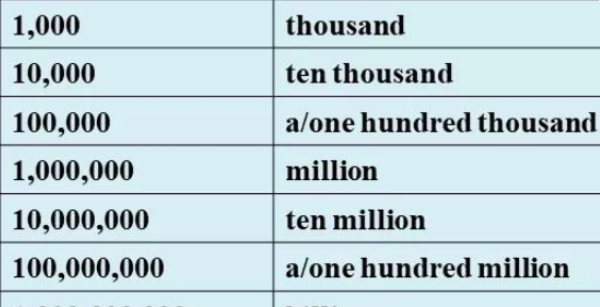
Expressing numbers in English can be confusing to both students and those listening. Make sure you understand how to express numbers in spoken English by following these rules.
用英语表达数字,无论是对学生还是听者来说都是容易令人困惑的。通过遵循以下这些规则,可以确保你懂得如何用英语表达数字。
Below you will find numbers written out in order to helps students learn the correct grouping in English. Generally speaking, numbers larger than twenty should always be expressed by numbers in written English:
你会发现下面写出的数字是为了帮助学生学习正确的分组。一般来说,大于二十的数在书面英语中应该用数字表示:
I have fifteen clients in New York.
我在纽约有十五个客户。
She has 240 contacts on her mailing list.
她的邮件列表上有240个联系人。
Tens
十位数
Say individual numbers between one and twenty. After that, use the tens (twenty, thirty, etc.) followed by the numbers one through nine:
一到二十之间,我们读单个的数字。二十往后,使用十位数(二十,三十等),紧接数字一到九:
7 - seven
19 - nineteen
英语数字怎么读
您好:两位和三位数的读法是读所有数字的基础。英文数字中的每一个逗点的读法也要牢记:有一个逗点读"thousand",两个逗点读"million",三个逗点读"billion"。还要清楚,每个逗点间 由三位数组成。
英文数字中的第四位数、第七位数、第十位数是很关键的数位。
Examples:
1,234 读作:one thousand,two hundred and thirty-four
4,567,809 读作:four million,five hundred and sixty-seventhousand,eight hundred
and nine
5,678,120,000 读作:five billion,six hundred and seventy-eight million,one
hundred and twe nty thousand
1 400 ,000,100 ,000, 000 这个数字由于过长,可以使用一兆这个词(trillion)即一万亿 这个数字可以读作One hundred and forty trillion.
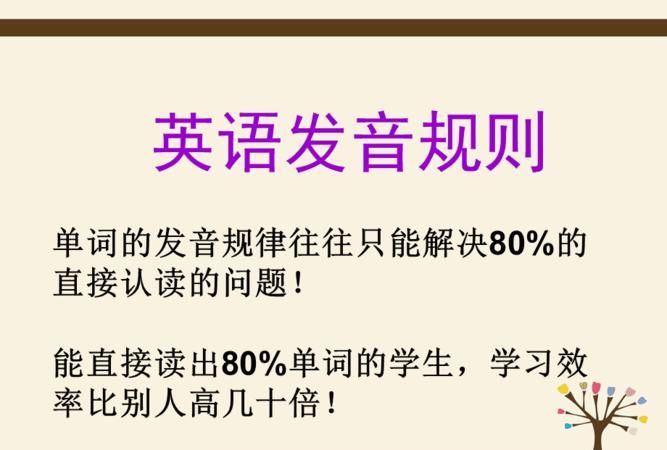
英语十个数字怎么读
英语数词从1000开始只有thousand(千, 后3个0),million(百万,后6个0),billion(十亿,后9个0)这三个单位,所以都化成这三个单位来念。
给出以下例子参照,
369:three hundred and sixty nine 三位数读法,百,其中由and连接百位和两位数
1483: one thousand four hundred and eighty three 四位数读法,千,直接千位加上三位数读法
13458: thirteen thousand four hundred and fifty eight 五位数读法,万,还是读成千,所以是十位数读法加上千的单位再加上三位数读法
134580: one hundred and thirty four thousand five hundred and eighty 六位数读法,十万,还是读成千,所以是百位数读法加上千的单位再加上百位数读法
1345820: one million three hundred and forty five thousand eight hundred and twenty 七位数读法,百万,所以从千单位thousand变成百万单位million,后面是一样规律,以千为单位读,所以是个位数读法加上百万单位再加上百位数读法加上千单位再加上百位数读法
13458216: thirteen million four hundred and fifty eight thousand two hundred and sixteen 八位数读法,千万,还是用million单位,所以是十位数读法加上百万单位再加上百位数读法加上千单位再加上百位数读法
134582160: one hundred and thirty four million five hundred and eighty two thousand one hundred and sixty 九位数读法,亿,还是用million单位,所以是百位数读法加上百万单位再加上百位数读法加上千单位再加上百位数读法
1345821690: one billion three hundred and forty five million eight hundred and twenty one thousand six hundred and ninety 十位数读法,十亿,从百万单位million换成十亿单位billion,所以是个位数读法加上十亿单位再加上百位数读法加上百万单位再加上百位数读法加上千单位再加上百位数读法
反正就是记住数字全读成以千,百万和十亿为单位的数字(3个0一进制),其他就用个位数和百位数直接读出即可
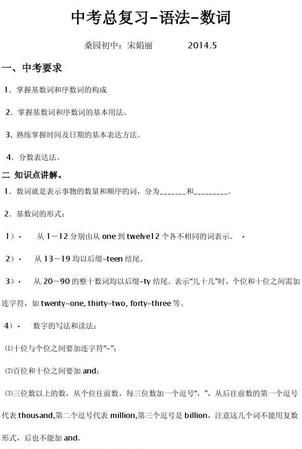
C语言怎么表示三位数
基数词
0 nought;zero;O
1 one
2 two
3 three
4 four
5 five
6 six
7 seven
8 eight
9 nine
10 ten
11 eleven
12 twelve
13 thirteen
14 fourteen
15 fifteen
16 sixteen
17 seventeen
18 eighteen
19 nineteen
20 twenty
21 twenty-one
22 twenty-two
23 twenty-three
30 thirty
32 thirty-two
40 forty
50 fifty
60 sixty
70 seventy
80 eighty
90 ninety
100 one hundred
101 one hundred and one
156 one hundred and fifty-six
192 one hundred and ninty-two
200 two hundred
300 three hundred
400 four hundred
500 five hundred
600 six hundred
700 seven hundred
800 eight hundred
900 nine hundred
1,000 one thousand
1,001 one thousand and one
1,300 thirteen hundred;one thousand and three hundred
2,000 two thousand
2,034 two thousand and thirty-four
6,502 six thousand five hundred and two
38,000 thirty-eight thousand
45,672 forty-five thousand six hundred and seventy-two
500,000 five hundred thousand
1,000,000 one million
3,123,400 three million,one hundred and twenty-three thousand and four hundred
8,000,000 eight million
47,000,000 forty-seven million
900,000,000 nine hundred million
1,000,000,000 a milliard,one milliard(美作:a billion,one billion)
1,050,000,000 one billion and fifty million
10,000,000,000 ten billion
200,000,000,000 two hundred billion
1,000,000,000,000 a billion,one billion(美作:a trillion,one trillion)
6,000,000,000,000 six million million
序数词
first 第一
second 第二
third 第三
fourth 第四
fifth 第五
sixth 第六
seventh 第七
eighth 第八
ninth 第九
tenth 第十
eleventh 第十一
twelfth 第十二
thirteenth 第十三
fourteenth 第十四
fifteenth 第十五
sixteenth 第十六
seventeenth 第十七
eighteenth 第十八
nineteenth 第十九
twentieth 第二十
twenty-first 第二十一
twenty-second 第二十二
twenty-third 第二十三
thirtieth 第三十
thirty-first 第三十一
fortieth 第四十
fiftieth 第五十
sixtieth 第六十
seventieth 第七十
eightieth 第八十
ninetieth 第九十
(one)hundredth 第一百
(one)hundred and first 第一百零一
hundred and thirty-fourth 第一百三十四
two-hundredth 第二百
three-hundredth 第三百
four-hundredth 第四百
five-hundredth 第五百
six-hundredth 第六百
seven-hundredth 第七百
eight-hundredth 第八百
nine-hundredth 第九百
(one)thousandth 第一千
thousand and first 第一千零一
two thousand and thirty-fourth
第二千零三十四
ten thousandth 第一万
(one)millionth 第一百万(美作:billionth)
billionth 第十亿(美作:trillionth)
1/2 : one-half;a half
1/3 : one-third
3/4 : three-fourths
1/5 : one-fifth
2/5 : two-fifths
7/8 : seven-eighths
1/10 : one-tenth;a tenth
1/100 : one-hundredth;one per cent
1/1000 : one-thousandth
1/10000 : one ten-thousandth
2‘ 1/2:two and one half;two and a half
4’ 2/3:four and two-thirds
100% : one hundred percent
0.5% : point five percent
0.46% : point four six percent
2.05 : two point nought five;two point O five
6.003 : six point nought nought three;six point O O three
78.12 : seventy-eight point one two
119 : one one nine
120 : one two oh
688 : six double-eight
5337 : five double-three seven
6512 : six five one two
97868 : nine seven eight six eight
893493 : eight nine three four nine three
737964 : seven three seven nine six four
62374881 : six two three seven four double-eight one
1840 eighteen forty
1900 nineteen hundred
1992 nineteen ninety-two
美语与英语在日期、数字表达上的差异:
在日期方面,美英的表达方式是有差别的。以日为先,月份为后,此为英国式,美国式则与此相反。如一九九六年三月二日的写法:2nd March, 1996(英)March 2, 1996(美)在美式的写法中,1st, 2nd, 3rd的st, nd, rd是不使用的。由于日期书面表达不同,读法也不一样。如1987年4月20日,英式的写法是20th April, 1987,读成the twentieth of April, nineteen eighty-seven;美式的表达是April 20, 1987,则读成April the twentieth, nineteen eighty-seven。同样,全部用数字表达日期时,英美也有差别。1998年5月6日按照英国式应写成6/5/98,而按照美国式应写成5/6/98;01.08.1998是英国式的1998年8月1日,按照美国的表达方式却是1998年1月8日,美国的1998年8月1日应写成08,01,1998。因此,全部使用数字来表示日期时,往往发生误解,在商务活动中必须谨慎使用。
表达百万以上的数字概念英美的差别甚大,如one billion英语指的是"万亿""兆",而美语则只"十亿";one trillion英语晨相当于million million million=1018,是百万兆,在美语里却相当于英国英语的one billion,是"万亿"、"兆"。
在数字口头表达方面,两国也存在着差别。$175(175美元)英语读成a(one) hundred and seventy five dollars,美语读成one hundred seventy five dollars,常省略and;表达连续同样数字的号码时,英语习惯用double或triple,美语一般不这样用,如电话号码320112,英语读成three two zero, double one two,美语则读成three two zero one one two, 999 234英语读成nine double nine (triple nine) two three four,美语则读成nine nine nine two three four,不过美国人也把连续三个相同的号码读成three加上这个数字的复数形式,如999读成three nines。
时刻表示法
1. 表示几点钟用基数词加可以省略的o\'clock
5:00 读作 five o\'clock 或 five
2. 表示几点过几分,在分钟后加past,再加小时
five past seven 七点过五分
half past six 六点半
a quarter past eight 八点过一刻
seven past eight 八点过七分 3. 表示几点差几分,在分钟后面加to,再加小时
ten to eight 差十分八点(七点五十分)
a quarter to twelve 差一刻十二点(十一点四十五分)
twenty to six 差二十分六点(五点四十分)
在日常生活中,常用下列简单方法表示时间。
以小时、分种为单位分别读出数字。
6:31 读作 six thirty-one
10:26 读作 ten twenty-six
14:03 读作 fourteen o three
16:15 读作 sixteen fifteen
18:30 读作 eighteen thirty
23:55 读作 twenty-three fifty-five
注:时刻表上的时间大多采用24小时表示法,这样就不需要用a.m.表示上午,p.m.表示下午了。
年月表示法
1. 世纪可以用定冠词加序数词加世纪century表示,也可以用定冠词加百位进数加\'s表示
the sixth(6th)century 公元六世纪
the eighteenth(18th)century 公元十八世纪
the 1900\'s 二十世纪
the 1600\'s 十七世纪
这里,用百位数整数表示的世纪比这一百位阿拉伯数字本身多一个世纪。
2. 年代用定冠词及基数词表示的世纪加十位整数的复数形式构成
in the 1930\'s(in the thirties of the twentieth century或 in the nineteen thirties)
在二十世纪三十年代
in the 1860\'s(in the sixties of the 19th century或 in the eighteen sixties)
在十九世纪六十年代
In the 1870\'s when Marx was already in his fifties,he found it important to study the situation in Russia,so he began to learn Russian.
在十九世纪七十年代当马克思已经五十多岁时,他发现研究俄国的形势很重要,便开始学习俄语。
3. 表示某年代的早期、中期和晚期,可以在定冠词后,年代前添加 early,mid-,late
in the early 1920\'s 在二十世纪二十年代早期
in the mid-1950\'s 在二十世纪五十年代中期
4. 年月日表示法
A.年份用基数词表示,一般写为阿拉伯数字,读时可以以hundred为单位,也可以以世纪、年代为单位分别来读。
1949 读作 nineteen hundred and forty-nine 或 nineteen forty-nine
1800 读作 eighteen hundred
253 读作 two hundred and fifty-three或two fifty-three
1902 读作 nineteen hundred and two或 nineteen o two
表示在哪一年,一般在年数前加介词in,使用year时,year放在数词之前。
in the year two fifty-three B.C. 在公元前253年
但是,通常采用in加表示年份的阿拉伯数字。
B. 月份,在哪个月用介词in加第一个字母大写的月份词表示。例如:in May在五月; in July在七月。为了简便起见,月份与日期连用时,月份常用缩写形式表示。缩写形式除May,June,July外,其它的月份都由其前三个字母表示,但September除外。
January——Jan.一月 February——Feb.二月
March——Mar. 三月 April——Apr.四月
August——Aug.八月
September——Sept.九月
October——Oct.十月
November——Nov.十一月
December——Dec.十二月
注:这里缩写形式后面加点不能省略,因为它是表示缩写形式的符号。
C.日期用定冠词the加序数词表示。在哪一天要添加介词on。
National Day is on Oct. 1.
国庆节是十月一日。(读作 October first)
此句也可以表示为 National Day is on the 1st of October.
May 5 五月五日(读作May fifth)
也可以表示为the fifth(5th)of May
Mar. 1(st) 三月一日(读作March first或 the first of March)
5. 表示不具体、不确切的时间,如世纪、年代、年份、月份时,用介词in表示,表示具体确切的某一天用介词on表示通常情况下morning,afternoon,evening等词前用介词in。但是,当这些词前后有一修饰限定的词作为定语,把它们限定为某一天早晨、下午或晚上时,介词in应改为on。这里的修饰限定词可以是介词短语、名词、形容词、定语从句等。
On a cold morning,the old man died lonely in his house.
在一个寒冷的早晨,这个老人孤独地死在自己的房子里。
I don\'t want to be disturbed on nights when I have to study.
我不愿意在我必须学习的晚上被打扰。
The accident happened on the afternoon of July 7.
这次事故发生在7月7日下午。
We are to have a small test on Monday morning.
星期一早晨我们将进行一次小测验。
四、加减乘除表示法
1. “加”用plus,and或add表示;“等于”用is,make,equal等词表示。
2+3=? 可表示为: How much is two plus three?
2+3=5
Two plus three is five.
Two and three is equal to five.
Two and three make five.
Two added to three equals five.
If we add two to/and three, we get five.
二加三等于五
2. “减”用 minus或 take from表示
10-6=? How much is ten minus six?
10-6=4 Ten minus six is four.
Take six from ten and the remainder is four.
Six (taken) from ten is four.
十减去六等于四
3. “乘”用time(动词)或multiply表示
3X4=? How much is three times four?
3X4=12 Three times four is/are twelve.
Multiply three by four,we get twelve.
Three multiplied by four makes twelve.
三乘以四等于十二
4. “除”用divide的过去分词形式表示
16÷4=? How much is sixteen divided by four?
16÷4=4 Sixteen divided by four is four.
Sixteen divided by four equals/gives/makes four.
十六除以四等于四。
五、分数表示法
1. 分数是由基数词和序数词一起来表示的。基数词作分子,序数词作分母,除了分子是“1”以外,其它情况下序数词都要用复数形式。
3/4 three fourths或 three quarters
1/3 one third或a third
24/25 twenty-four twenty-fifths
3 1/4 three and one fourth或 three and one quarter
1/2 a half
1/4 one quarter或a quarter
1 1/2 one and a half
1 1/4 one and a quarter
2. 当分数后面接名词时,如果分数表示的值大于1,名词用复数;小于1,名词用单数。
1 1/2 hours 一个半小时(读作 one and a half hours)
2 3/4 meters 二又四分之三米(读作two and three-fourths meters)
4/5 meter 五分之四米
5/6 inch 六分之五英寸
3. 表示“n次方”的说法:指数用序数词,底数用基数词。
10的7次方 the seventh power of ten(ten to the seventh power)
6的10次方 the t enth power of six(six to the tenth power)
六 、小数表示法
1. 小数用基数词来表示,以小数点为界,小数点左首的数字为一个单位,表示整数,数字合起来读;小数点右首的数字为一个单位,表示小数,数字分开来读;小数点读作 point,o读作 zero或o〔ou〕,整数部分为零时,可以省略不读。
0.4 zero point four或point four 零点四
10.23 ten point two three 十点二三
25.67 twenty-five point six seven 二十五点六七
l.03 one point o three 一点零三
2. 当数字值大于1时,小数后面的名词用复数,数字值小于1时,小数后面的名词用单数。
1.03 meters 一点零三米 0.49 ton 零点四九吨
l.5 tons 一点五吨
七、百分数表示法
百分数用基数+percent表示
50% fifty percent 百分之五十
3% three percent 百分之三
0.12% zero point one two percent 百分之零点一二
这里的percent前半部per表示“每一”,cent这一后半部分表示“百”,所以百分之几中percent不用复数形式。
八、数量表示法
1. 表示长、宽、高、面积等,用基数词+单位词(meter,foot,inch,kilogram等)+ 形容词(long,wide,high等)表示,或者用基数词+单位词 + in + 名词(length, width, height, weight等)表示。
two meters long或 two meters in length 2米长
three feet high或 three feet in height 3英尺高
four inches wide或 four inches in width 4英寸宽
This box is 2 kilograms in weight.
这个盒子有两千克重。
The city wall of Xi\'an is 12 meters wide and 12 meters high.
西安城墙是12米宽,12米高。
2. 表示时间、距离时,使用含数词的名词所有格形式作定语。
five minutes\' walk
步行五分钟(的距离)
It\'s an hour\'s ride from my hometown to our university.
从我的家乡到我们大学是乘车一小时的路程。
或:从我的家乡到我们大学需要乘车一小时。
It\'s three kilometers\' distance from our campus to the Bell Tower.
从我们校园到钟楼有三公里远。
3. 表示温度时,用below zero表示零下温度,温度用基数词+degree(s)+单位词(centigrade摄氏或Fahrenheit华氏)表示。
thirty-six degrees centigrade或 36℃ 摄氏 36度
four degrees below zero centigrade或 -4℃ 摄氏零下4度
Water freezes at thirty-two degrees Fahrenheit.
水在华氏三十二度时结冰。
Water boils at one hundred degrees centigrade.
水在摄氏一百度时沸腾。
这里的单位词在人们都很清楚是什么度量制度时,可以省略。
You are 37℃.(读作 thirty-seven degrees)
你是三十七度。(摄氏)
It\'s seven degrees below zero.
今天是零下七度。(摄氏)
4. 由数词和其他名词构成的名词性短语作定语时,其中的名词用单数形式,名词性短语中各部分间要用连字符“-”来连接。
It\'s a five-minute walk from the library to the playground.
从图书馆到操场需要走五分钟。
She\'s a sixteen-year-old girl.
她是个十六岁的女孩。
5. 表示“比•••大(或)几倍”的说法。
This room is two times bigger than that one.
这个房间比那个(房间)大两倍。
The dictionary is four times thicker than that book.
这本词典比那本书厚四倍。
My age is two times older than his.
我的年龄比他大两倍。
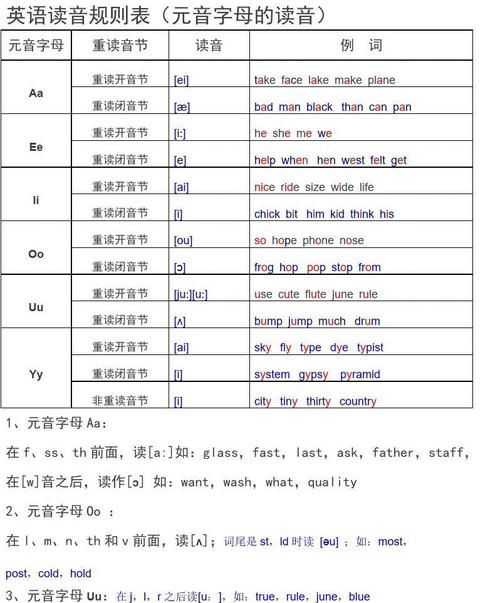
以上就是关于英语三位数的读法规则,英语中数字的读法规则百度文库PPT的全部内容,以及英语三位数的读法规则 的相关内容,希望能够帮到您。

